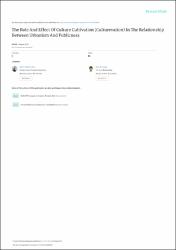| dc.contributor.author | Erbaş, Adem Erdem | en_US |
| dc.contributor.author | Bengü, Devran | en_US |
| dc.date.accessioned | 2019-05-30T13:17:13Z | |
| dc.date.available | 2019-05-30T13:17:13Z | |
| dc.date.issued | 2018 | |
| dc.identifier.citation | Erbas, A. E., & Bengu, D. (2018). The Role and Effect of Culture Cultivation (Culturevation) in the Relationship between Urbanism and Publicness. Planlama-Planning, 28(2), 127-142. doi:10.14744/planlama.2018.85570 | en_US |
| dc.identifier.issn | 1300-7319 | |
| dc.identifier.uri | https://hdl.handle.net/20.500.12294/1447 | |
| dc.description | Bengü, Devran (Arel Author) | en_US |
| dc.description.abstract | In urbanism and architecture, the concepts of the public sphere, publicness, and public space have been used either as separate domains or as substitutes. However in a democratic society, these 3 concepts actually constitute a holistic whole. This point of view can only be advanced in an atmosphere of productivity that is not only non-consumerist, but which also differs from the contemporary capitalist production environment. When the art of theater is examined in relation to the development of publicness, it is possible to find spaces that may be tools of this different productivity that vitalizes the public sphere. There is quite a strong philosophical and historical connection between the development of publicness and the art of theater. In this article, the argument that theater is an influential tool in the relationship between urbanism and publicness is supported by the findings of field surveys conducted in the historic city center of the Kadikoy district of Istanbul. The findings suggest that the productivity of the rapidly increasing and accepted "alternative stages" of new generation theater spaces have characteristics that are different from the contemporary capitalist system. This productivity, which is visible in the environment of the new generation theater spaces nourishes publicness. This form of productivity that has emerged in the environment of the alternative stages observed in the field research is termed "culture cultivation" or "culturevation." This article provides a definition of culturevation and a discussion of the effective dynamics in the context of culturevation using data obtained in the field. Attention is drawn to how the existing publicness of local administrative structures, where the entirety of the public cultural production dynamic can be addressed, can be evaluated from a different perspective as sociocultural spaces that serve publicness. | en_US |
| dc.language.iso | tur | en_US |
| dc.publisher | Kare | en_US |
| dc.relation.ispartof | Planlama-Planning | en_US |
| dc.identifier.doi | 10.14744/planlama.2018.85570 | en_US |
| dc.identifier.doi | 10.14744/planlama.2018.85570 | |
| dc.rights | info:eu-repo/semantics/openAccess | en_US |
| dc.subject | Kadıköy | en_US |
| dc.subject | Public Space | en_US |
| dc.subject | Publicness | en_US |
| dc.subject | Public Sphere | en_US |
| dc.subject | Theatre | en_US |
| dc.title | The Role and Effect of Culture Cultivation (Culturevation) in the Relationship between Urbanism and Publicness | en_US |
| dc.type | article | en_US |
| dc.department | İstanbul Arel Üniversitesi, Mühendislik ve Mimarlık Fakültesi, Mimarlık Bölümü | en_US |
| dc.authorid | https://orcid.org/0000-0002-1193-1711 | en_US |
| dc.identifier.volume | 28 | en_US |
| dc.identifier.issue | 2 | en_US |
| dc.identifier.startpage | 127 | en_US |
| dc.identifier.endpage | 142 | en_US |
| dc.relation.publicationcategory | Makale - Uluslararası Hakemli Dergi - Kurum Öğretim Elemanı | en_US |


















